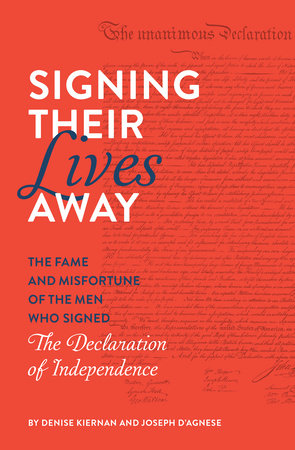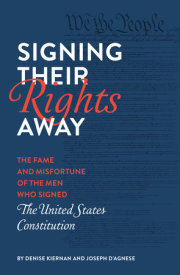Introduction:In 1776, fifty-six men risked their lives to defy the British and sign their names to the Declaration of Independence, but most Americans can’t name more than a handful.
There’s John Hancock, of course. And most people will correctly identify Thomas Jefferson, Benjamin Franklin, and John Adams. But then the guessing begins: George Washington? Paul Revere? Thomas Paine?
The Declaration of Independence is America’s birth certificate, its most celebrated document, and a model for later declarations crafted by struggling peoples the world over. Its signers were men
who drew upon the best within themselves in the face of horrifyingly difficult circumstances.
They also lived remarkably interesting lives. True, most of them were privileged members of the elite upper classes, but quite a few were just the opposite. And all these men were impacted by death, suffering, and adversity. Many were orphaned; even more lost children and wives for no other reason than that, in those days, the flu was deadly. So was asthma. So was a bad bout of diarrhea. Yet all these men carried on.
Over the years, we’ve read newspaper articles and junk e-mails seeking to quantify and magnify the sufferings of the signers. Every July, their miseries are dusted off and trotted out along with barbecues and flags. It’s a shame that this is the only time of year Americans think about these men. But it’s even more disheartening to discover that most of the stories are just plain false.
In the end, it doesn’t matter that none of the signers were killed for affixing their name to the Declaration of Independence or that none died in battle. What does matter is that they came together one sweltering summer under distressing circumstances and, despite huge differences in opinion, backgrounds, and values, decided to band together and form a new nation. Doing so was, without a doubt, an enormous, life-threatening risk, and if the colonies had not been triumphan—and honestly, it’s astounding that they were—these men would have surely been, as they used to say back in the day, fitted with a “halter.”
As the Declaration of Independence so eloquently states in its last line, they risked their lives, their fortunes, and their sacred honor.
We think they are worth knowing.
A Clarification: The Real Independence DayHappy Fourth of July! Wait, scratch that. We mean: Happy Second of July! Hold on, that’s still not right: Happy Second of August!
John Adams thought that future generations of Americans should celebrate Independence Day “with Pomp and Parade, with Shows, Games, Sports, Guns, Bells, Bonfires and Illuminations from one End of this Continent to the other from this Time forward forever more.” Adams omitted the burgers, hot dogs, and beer kegs, but his heart was in the right place. Oddly, when he wrote these words to his wife, Abigail, on July 3, 1776, he wasn’t talking about the Fourth of July. He was speaking of what he considered to be the nation’s true birthday: July 2, 1776.
The events leading up to that date were as follows: On June 7, 1776, Richard Henry Lee of Virginia proposed that the colonies break with England. Though the citizenry had debated this point for years, the thought of finally doing the deed shook the delegates. To calm themselves, they did what any political body would do: they postponed the vote for a month. During that time, a committee of five congressmen—Thomas Jefferson, Benjamin Franklin, John Adams, Robert R. Livingston, and Roger Sherman—was appointed to write the Declaration of Independence. Jefferson ended up doing most of the heavy lifting, with some editorial suggestions from Adams and Franklin.
Tensions were running high by July 1, the day of an “unofficial” vote. Only nine colonies supported the break. South Carolina and Pennsylvania voted no, Delaware was deadlocked, and New York abstained. But when the official vote came on July 2, twelve of the thirteen colonies voted in favor. New York abstained again; they were waiting for permission that was held up in Ye Olde Trafficke but promised they would likely vote yea in a few days. It wasn’t exactly unanimous, but Congress went with it anyway. The motion carried. A new nation was born.
For the next two days, Congress polished the language of the Declaration, and the document was officially adopted on July 4. But only two men—President of Congress John Hancock and his secretary, Charles Thomson—actually signed the document on that day. Shortly after, a local printer named John Dunlap set the words into type, and about 200 copies were distributed throughout the new thirteen states. When Americans saw the July 4 date emblazoned at the top of Dunlap’s broadside, they mistook the date of adoption for the day of the momentous vote. In fact, it wasn’t until August 2, 1776, that the majority of the signers affixed their signatures to a fancier version of the “unanimous” Declaration—the one displayed today at the National Archives in Washington, D.C.
By August 1776, thousands of colonists were already regarding July 4 as the most important date in their fledgling nation’s history. To avoid upsetting this pleasant fiction, Congress sneakily backdated some official records to show that all fifty-six men had signed on July 4, 1776. Of course, this introduced a bizarre anachronism into the final record: the men who were present in Philadelphia and who voted for independence on July 2 were not the same group of men who signed on August 2! By the time August 2 rolled around, some of the original voters were out of town, fighting in the war, helping their states write new constitutions—or they had been replaced by entirely new delegates. Moreover, not all the delegates could make it to the big affair on August 2, and so they signed when they could get around to it—one as late as 1781.
But that doesn’t make for a tidy story, does it? No wonder Americans have wished one another a Happy Fourth of July ever since.
Copyright © 2019 by Denise Kiernan and Joseph D'Agnese. All rights reserved. No part of this excerpt may be reproduced or reprinted without permission in writing from the publisher.









